BSBLED802: Leading Learning Strategy Implementation - Sim's Hardware
VerifiedAdded on 2023/05/29
|20
|3822
|221
Report
AI Summary
This report details the implementation of a learning strategy within Sim's Hardware, focusing on aligning training and development with the organization's mission, vision, and strategic objectives. It covers various aspects including feedback collection, knowledge management, policy deployment, and resource allocation. The report evaluates different organizational learning models and outlines the phases of learning strategy development, emphasizing the importance of aligning learning with HR requirements. It also includes the design of a learning and development strategy, policies, and procedures for complaint assessment, recognition, procurement, and supply. The implementation phase involves reviewing policies, evaluating strategic outcomes, and updating procedures to maintain relevance and effectiveness. This document is available on Desklib, where students can find a wide array of study resources including past papers and solved assignments.
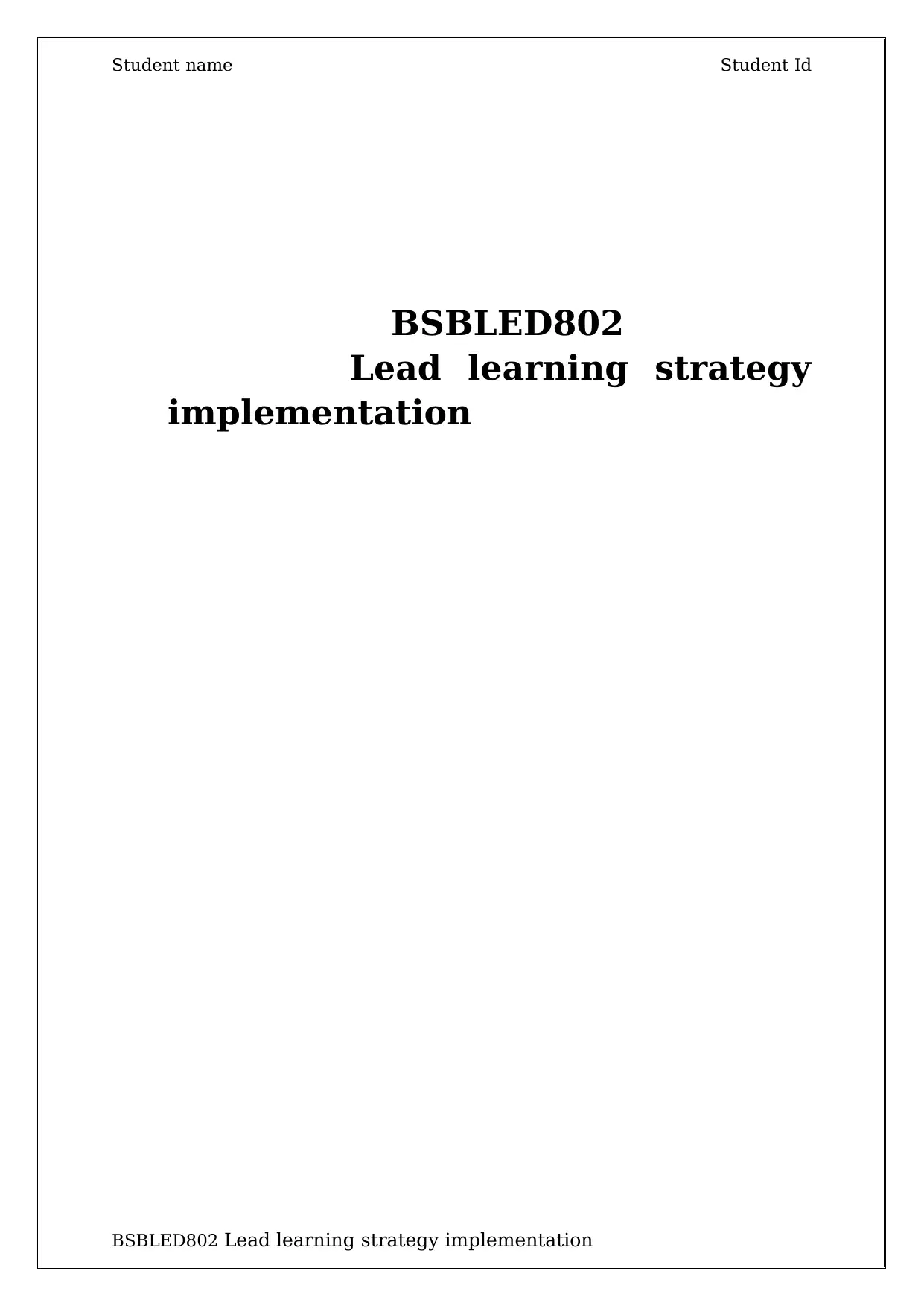
Student name Student Id
BSBLED802
Lead learning strategy
implementation
BSBLED802 Lead learning strategy implementation
BSBLED802
Lead learning strategy
implementation
BSBLED802 Lead learning strategy implementation
Paraphrase This Document
Need a fresh take? Get an instant paraphrase of this document with our AI Paraphraser
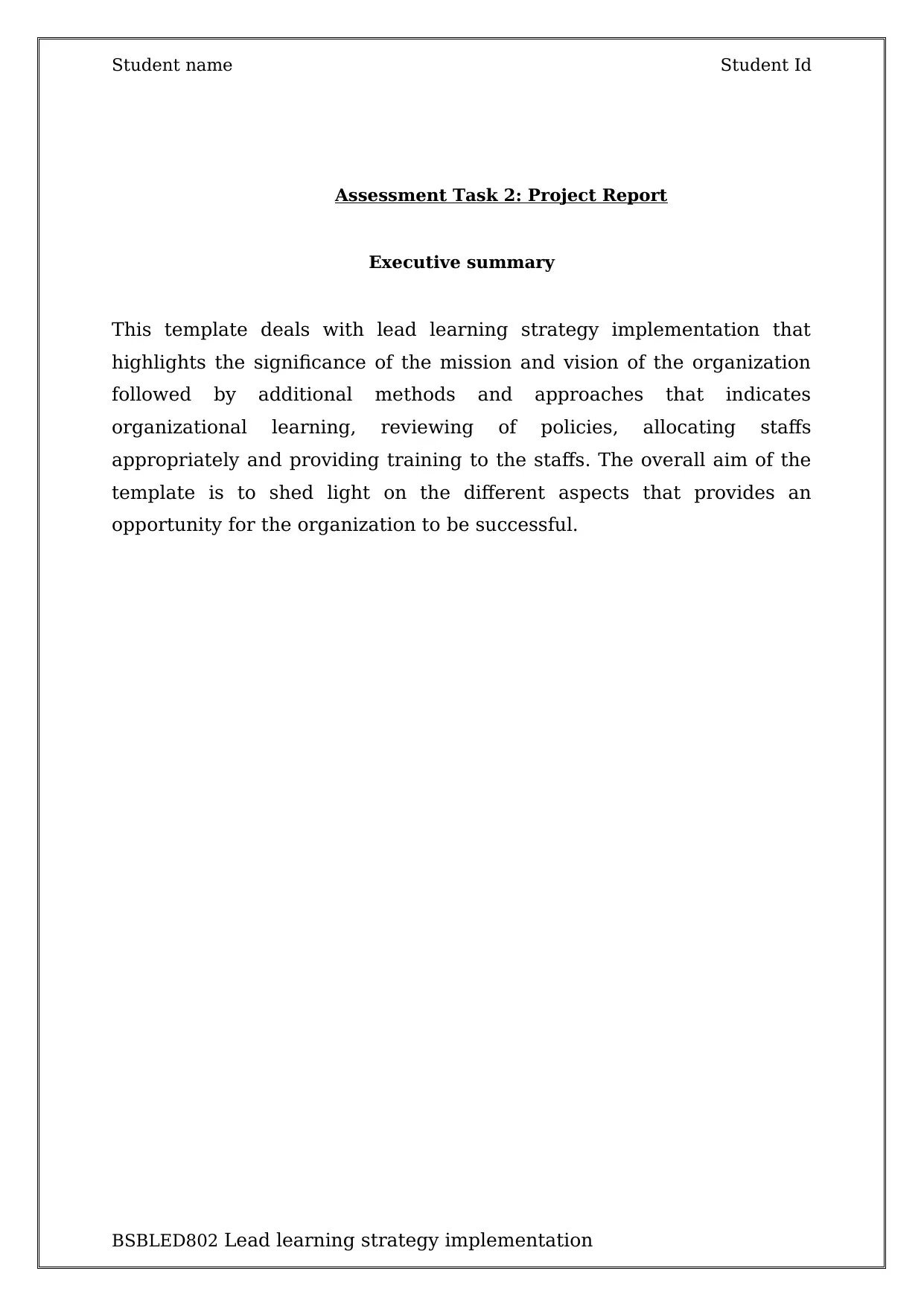
Student name Student Id
Assessment Task 2: Project Report
Executive summary
This template deals with lead learning strategy implementation that
highlights the significance of the mission and vision of the organization
followed by additional methods and approaches that indicates
organizational learning, reviewing of policies, allocating staffs
appropriately and providing training to the staffs. The overall aim of the
template is to shed light on the different aspects that provides an
opportunity for the organization to be successful.
BSBLED802 Lead learning strategy implementation
Assessment Task 2: Project Report
Executive summary
This template deals with lead learning strategy implementation that
highlights the significance of the mission and vision of the organization
followed by additional methods and approaches that indicates
organizational learning, reviewing of policies, allocating staffs
appropriately and providing training to the staffs. The overall aim of the
template is to shed light on the different aspects that provides an
opportunity for the organization to be successful.
BSBLED802 Lead learning strategy implementation
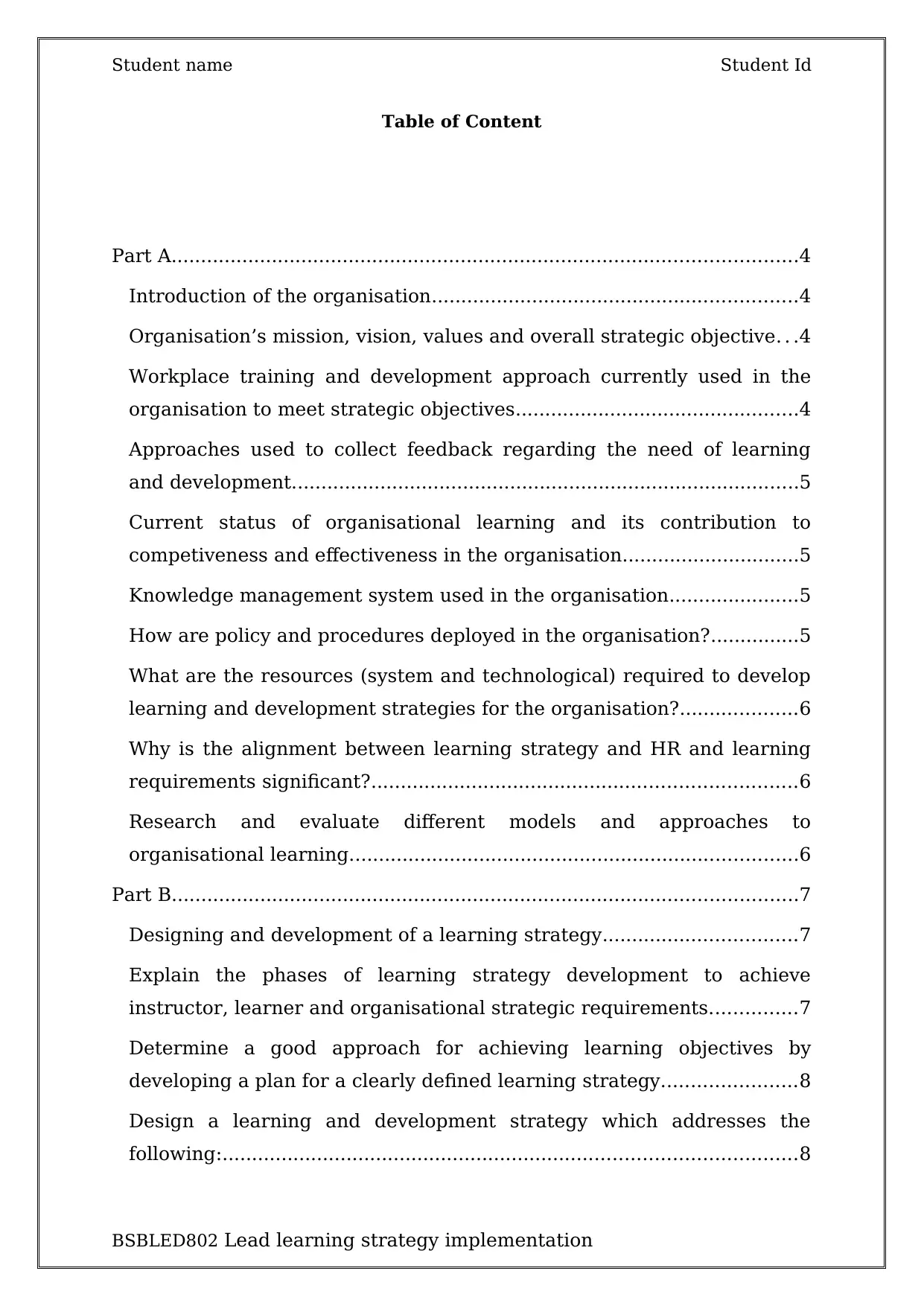
Student name Student Id
Table of Content
Part A..........................................................................................................4
Introduction of the organisation..............................................................4
Organisation’s mission, vision, values and overall strategic objective. . .4
Workplace training and development approach currently used in the
organisation to meet strategic objectives................................................4
Approaches used to collect feedback regarding the need of learning
and development......................................................................................5
Current status of organisational learning and its contribution to
competiveness and effectiveness in the organisation..............................5
Knowledge management system used in the organisation......................5
How are policy and procedures deployed in the organisation?...............5
What are the resources (system and technological) required to develop
learning and development strategies for the organisation?....................6
Why is the alignment between learning strategy and HR and learning
requirements significant?........................................................................6
Research and evaluate different models and approaches to
organisational learning............................................................................6
Part B..........................................................................................................7
Designing and development of a learning strategy.................................7
Explain the phases of learning strategy development to achieve
instructor, learner and organisational strategic requirements...............7
Determine a good approach for achieving learning objectives by
developing a plan for a clearly defined learning strategy.......................8
Design a learning and development strategy which addresses the
following:.................................................................................................8
BSBLED802 Lead learning strategy implementation
Table of Content
Part A..........................................................................................................4
Introduction of the organisation..............................................................4
Organisation’s mission, vision, values and overall strategic objective. . .4
Workplace training and development approach currently used in the
organisation to meet strategic objectives................................................4
Approaches used to collect feedback regarding the need of learning
and development......................................................................................5
Current status of organisational learning and its contribution to
competiveness and effectiveness in the organisation..............................5
Knowledge management system used in the organisation......................5
How are policy and procedures deployed in the organisation?...............5
What are the resources (system and technological) required to develop
learning and development strategies for the organisation?....................6
Why is the alignment between learning strategy and HR and learning
requirements significant?........................................................................6
Research and evaluate different models and approaches to
organisational learning............................................................................6
Part B..........................................................................................................7
Designing and development of a learning strategy.................................7
Explain the phases of learning strategy development to achieve
instructor, learner and organisational strategic requirements...............7
Determine a good approach for achieving learning objectives by
developing a plan for a clearly defined learning strategy.......................8
Design a learning and development strategy which addresses the
following:.................................................................................................8
BSBLED802 Lead learning strategy implementation
⊘ This is a preview!⊘
Do you want full access?
Subscribe today to unlock all pages.

Trusted by 1+ million students worldwide
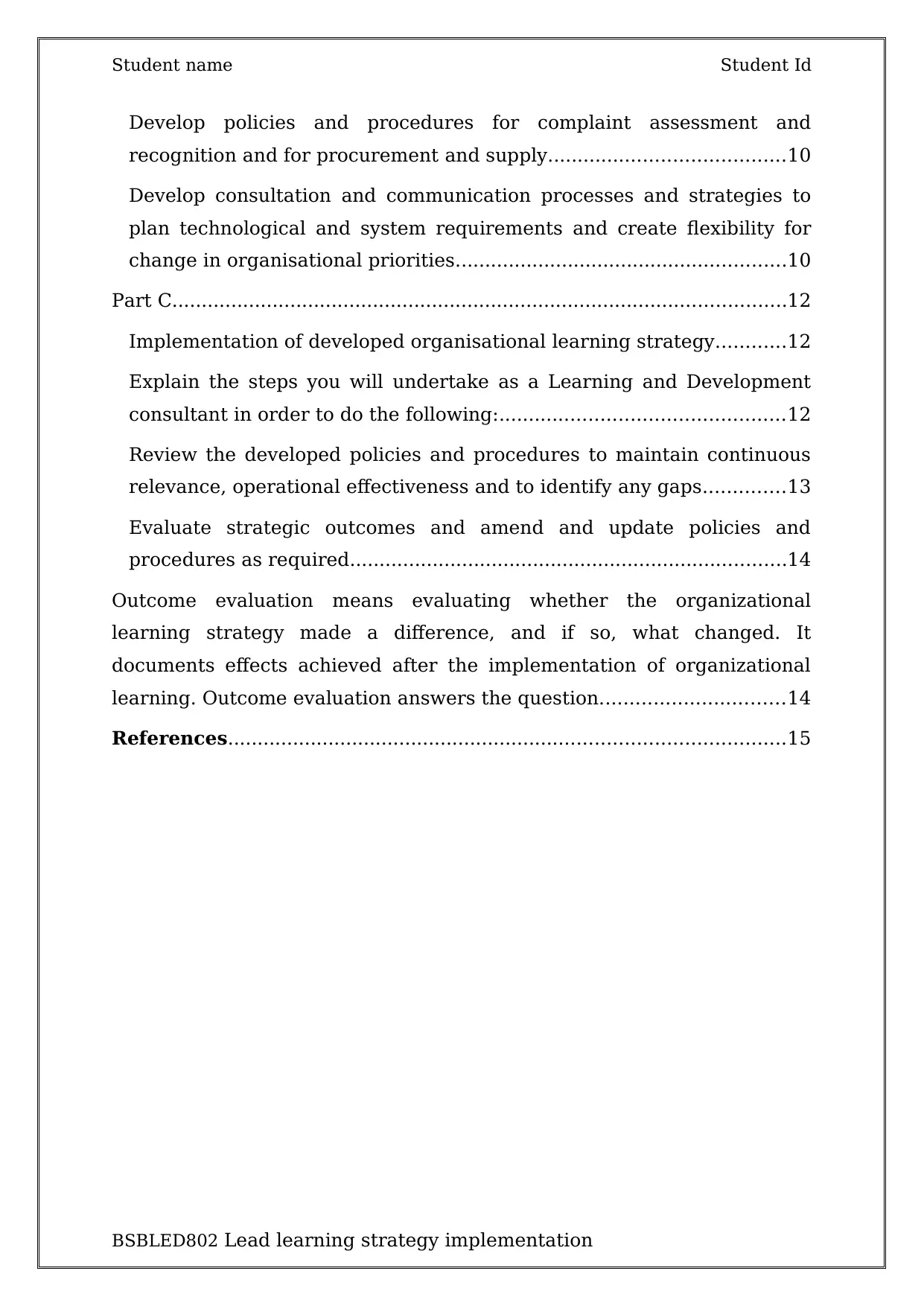
Student name Student Id
Develop policies and procedures for complaint assessment and
recognition and for procurement and supply........................................10
Develop consultation and communication processes and strategies to
plan technological and system requirements and create flexibility for
change in organisational priorities........................................................10
Part C........................................................................................................12
Implementation of developed organisational learning strategy............12
Explain the steps you will undertake as a Learning and Development
consultant in order to do the following:................................................12
Review the developed policies and procedures to maintain continuous
relevance, operational effectiveness and to identify any gaps..............13
Evaluate strategic outcomes and amend and update policies and
procedures as required..........................................................................14
Outcome evaluation means evaluating whether the organizational
learning strategy made a difference, and if so, what changed. It
documents effects achieved after the implementation of organizational
learning. Outcome evaluation answers the question...............................14
References..............................................................................................15
BSBLED802 Lead learning strategy implementation
Develop policies and procedures for complaint assessment and
recognition and for procurement and supply........................................10
Develop consultation and communication processes and strategies to
plan technological and system requirements and create flexibility for
change in organisational priorities........................................................10
Part C........................................................................................................12
Implementation of developed organisational learning strategy............12
Explain the steps you will undertake as a Learning and Development
consultant in order to do the following:................................................12
Review the developed policies and procedures to maintain continuous
relevance, operational effectiveness and to identify any gaps..............13
Evaluate strategic outcomes and amend and update policies and
procedures as required..........................................................................14
Outcome evaluation means evaluating whether the organizational
learning strategy made a difference, and if so, what changed. It
documents effects achieved after the implementation of organizational
learning. Outcome evaluation answers the question...............................14
References..............................................................................................15
BSBLED802 Lead learning strategy implementation
Paraphrase This Document
Need a fresh take? Get an instant paraphrase of this document with our AI Paraphraser
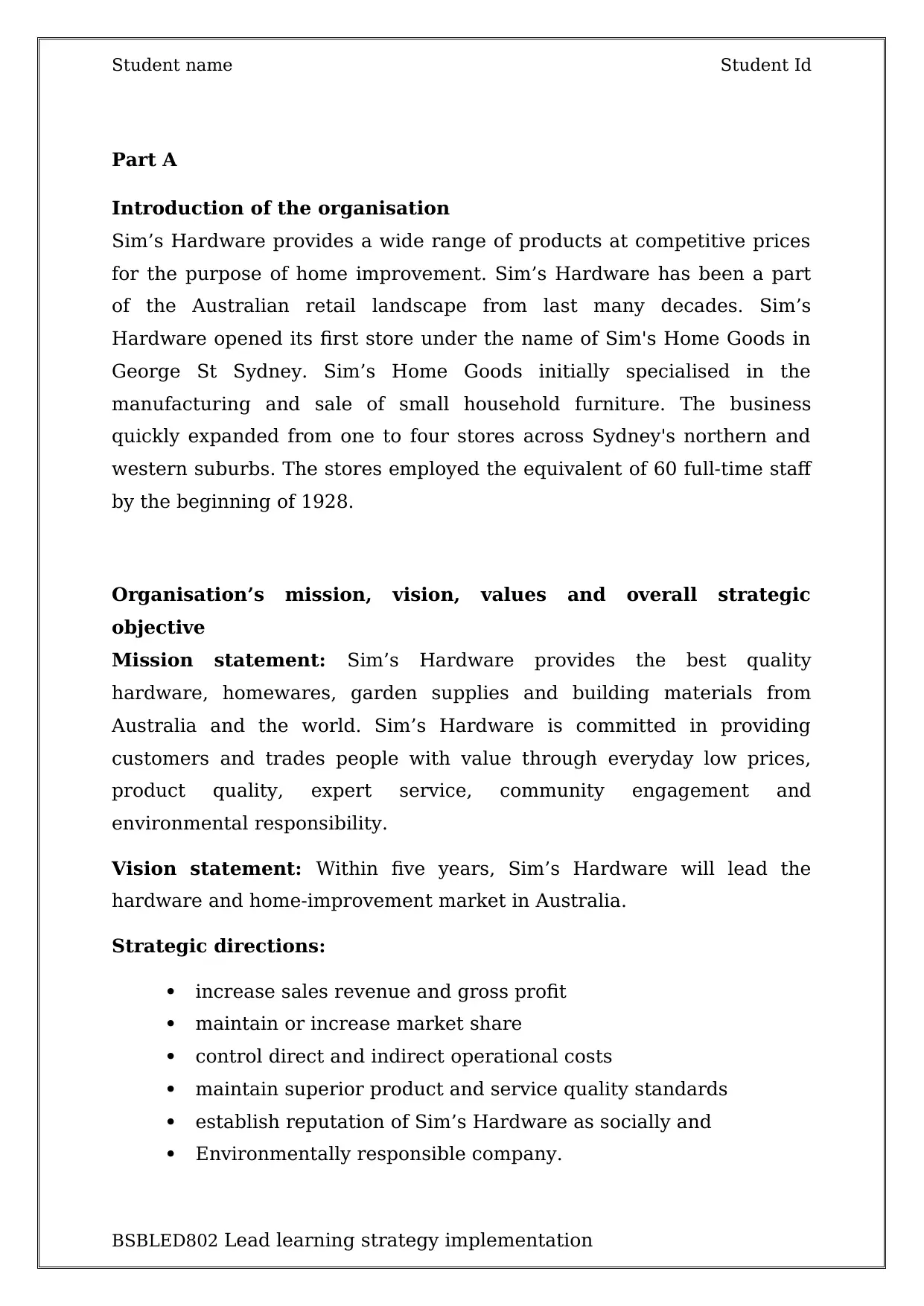
Student name Student Id
Part A
Introduction of the organisation
Sim’s Hardware provides a wide range of products at competitive prices
for the purpose of home improvement. Sim’s Hardware has been a part
of the Australian retail landscape from last many decades. Sim’s
Hardware opened its first store under the name of Sim's Home Goods in
George St Sydney. Sim’s Home Goods initially specialised in the
manufacturing and sale of small household furniture. The business
quickly expanded from one to four stores across Sydney's northern and
western suburbs. The stores employed the equivalent of 60 full-time staff
by the beginning of 1928.
Organisation’s mission, vision, values and overall strategic
objective
Mission statement: Sim’s Hardware provides the best quality
hardware, homewares, garden supplies and building materials from
Australia and the world. Sim’s Hardware is committed in providing
customers and trades people with value through everyday low prices,
product quality, expert service, community engagement and
environmental responsibility.
Vision statement: Within five years, Sim’s Hardware will lead the
hardware and home-improvement market in Australia.
Strategic directions:
increase sales revenue and gross profit
maintain or increase market share
control direct and indirect operational costs
maintain superior product and service quality standards
establish reputation of Sim’s Hardware as socially and
Environmentally responsible company.
BSBLED802 Lead learning strategy implementation
Part A
Introduction of the organisation
Sim’s Hardware provides a wide range of products at competitive prices
for the purpose of home improvement. Sim’s Hardware has been a part
of the Australian retail landscape from last many decades. Sim’s
Hardware opened its first store under the name of Sim's Home Goods in
George St Sydney. Sim’s Home Goods initially specialised in the
manufacturing and sale of small household furniture. The business
quickly expanded from one to four stores across Sydney's northern and
western suburbs. The stores employed the equivalent of 60 full-time staff
by the beginning of 1928.
Organisation’s mission, vision, values and overall strategic
objective
Mission statement: Sim’s Hardware provides the best quality
hardware, homewares, garden supplies and building materials from
Australia and the world. Sim’s Hardware is committed in providing
customers and trades people with value through everyday low prices,
product quality, expert service, community engagement and
environmental responsibility.
Vision statement: Within five years, Sim’s Hardware will lead the
hardware and home-improvement market in Australia.
Strategic directions:
increase sales revenue and gross profit
maintain or increase market share
control direct and indirect operational costs
maintain superior product and service quality standards
establish reputation of Sim’s Hardware as socially and
Environmentally responsible company.
BSBLED802 Lead learning strategy implementation
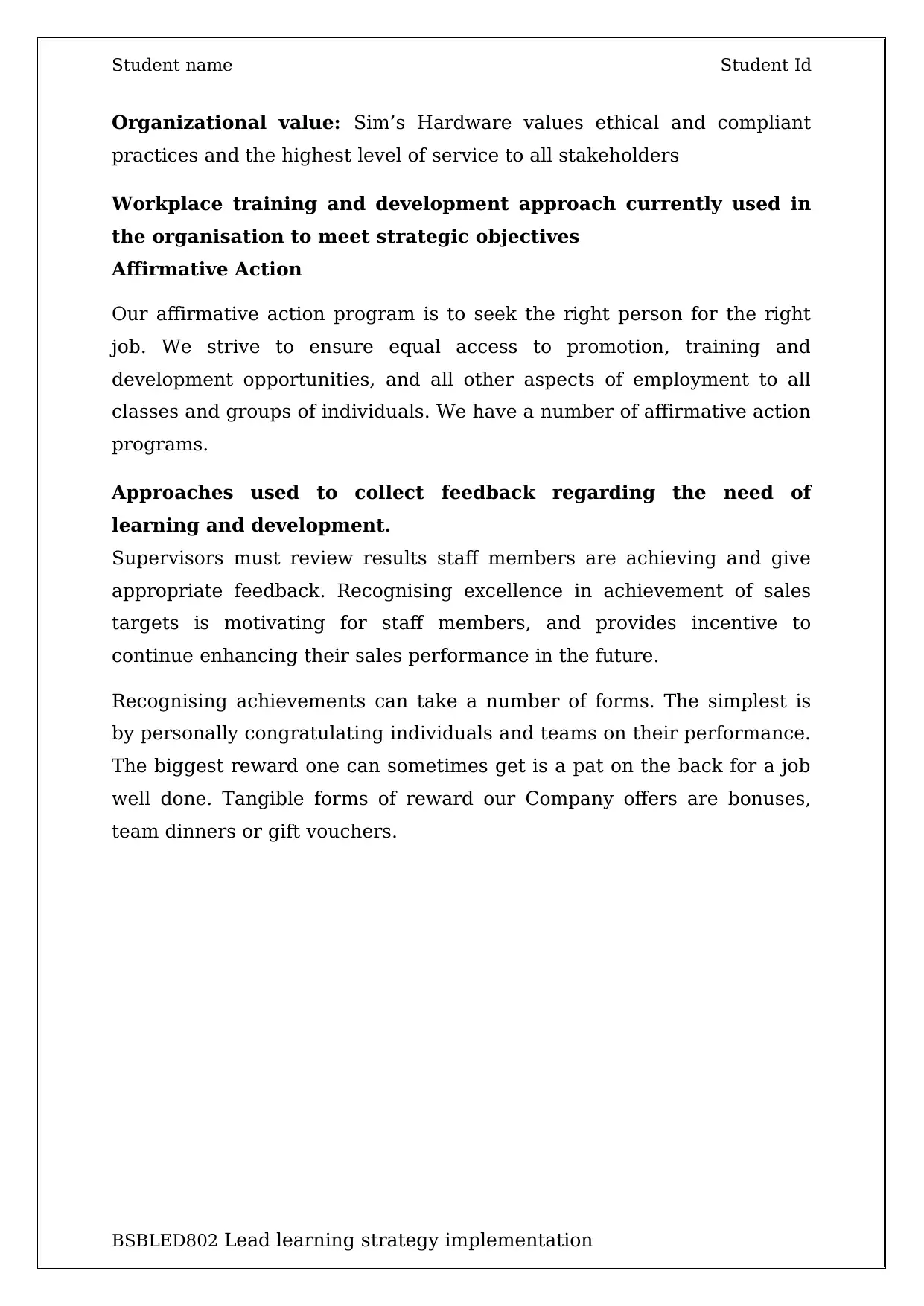
Student name Student Id
Organizational value: Sim’s Hardware values ethical and compliant
practices and the highest level of service to all stakeholders
Workplace training and development approach currently used in
the organisation to meet strategic objectives
Affirmative Action
Our affirmative action program is to seek the right person for the right
job. We strive to ensure equal access to promotion, training and
development opportunities, and all other aspects of employment to all
classes and groups of individuals. We have a number of affirmative action
programs.
Approaches used to collect feedback regarding the need of
learning and development.
Supervisors must review results staff members are achieving and give
appropriate feedback. Recognising excellence in achievement of sales
targets is motivating for staff members, and provides incentive to
continue enhancing their sales performance in the future.
Recognising achievements can take a number of forms. The simplest is
by personally congratulating individuals and teams on their performance.
The biggest reward one can sometimes get is a pat on the back for a job
well done. Tangible forms of reward our Company offers are bonuses,
team dinners or gift vouchers.
BSBLED802 Lead learning strategy implementation
Organizational value: Sim’s Hardware values ethical and compliant
practices and the highest level of service to all stakeholders
Workplace training and development approach currently used in
the organisation to meet strategic objectives
Affirmative Action
Our affirmative action program is to seek the right person for the right
job. We strive to ensure equal access to promotion, training and
development opportunities, and all other aspects of employment to all
classes and groups of individuals. We have a number of affirmative action
programs.
Approaches used to collect feedback regarding the need of
learning and development.
Supervisors must review results staff members are achieving and give
appropriate feedback. Recognising excellence in achievement of sales
targets is motivating for staff members, and provides incentive to
continue enhancing their sales performance in the future.
Recognising achievements can take a number of forms. The simplest is
by personally congratulating individuals and teams on their performance.
The biggest reward one can sometimes get is a pat on the back for a job
well done. Tangible forms of reward our Company offers are bonuses,
team dinners or gift vouchers.
BSBLED802 Lead learning strategy implementation
⊘ This is a preview!⊘
Do you want full access?
Subscribe today to unlock all pages.

Trusted by 1+ million students worldwide
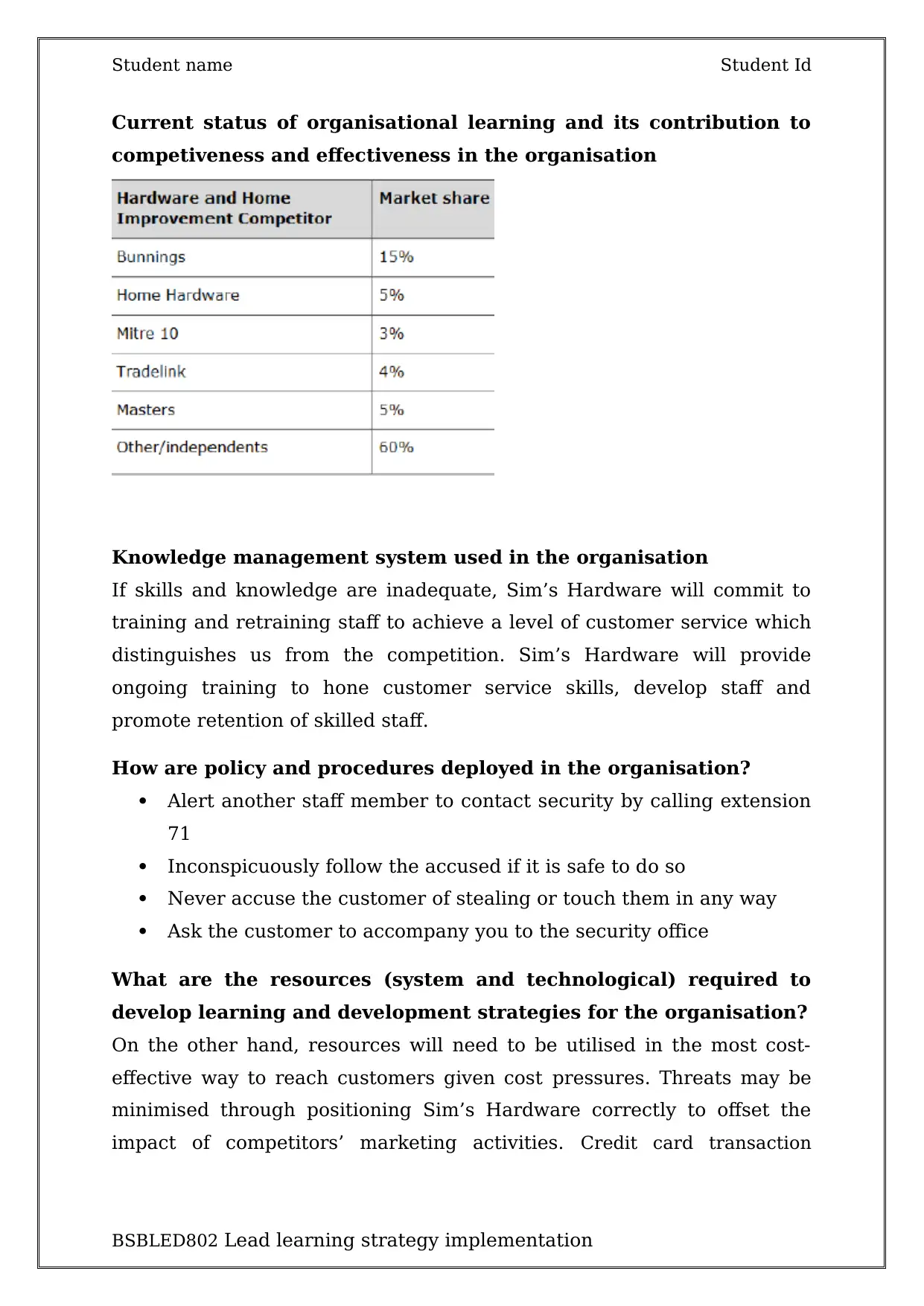
Student name Student Id
Current status of organisational learning and its contribution to
competiveness and effectiveness in the organisation
Knowledge management system used in the organisation
If skills and knowledge are inadequate, Sim’s Hardware will commit to
training and retraining staff to achieve a level of customer service which
distinguishes us from the competition. Sim’s Hardware will provide
ongoing training to hone customer service skills, develop staff and
promote retention of skilled staff.
How are policy and procedures deployed in the organisation?
Alert another staff member to contact security by calling extension
71
Inconspicuously follow the accused if it is safe to do so
Never accuse the customer of stealing or touch them in any way
Ask the customer to accompany you to the security office
What are the resources (system and technological) required to
develop learning and development strategies for the organisation?
On the other hand, resources will need to be utilised in the most cost-
effective way to reach customers given cost pressures. Threats may be
minimised through positioning Sim’s Hardware correctly to offset the
impact of competitors’ marketing activities. Credit card transaction
BSBLED802 Lead learning strategy implementation
Current status of organisational learning and its contribution to
competiveness and effectiveness in the organisation
Knowledge management system used in the organisation
If skills and knowledge are inadequate, Sim’s Hardware will commit to
training and retraining staff to achieve a level of customer service which
distinguishes us from the competition. Sim’s Hardware will provide
ongoing training to hone customer service skills, develop staff and
promote retention of skilled staff.
How are policy and procedures deployed in the organisation?
Alert another staff member to contact security by calling extension
71
Inconspicuously follow the accused if it is safe to do so
Never accuse the customer of stealing or touch them in any way
Ask the customer to accompany you to the security office
What are the resources (system and technological) required to
develop learning and development strategies for the organisation?
On the other hand, resources will need to be utilised in the most cost-
effective way to reach customers given cost pressures. Threats may be
minimised through positioning Sim’s Hardware correctly to offset the
impact of competitors’ marketing activities. Credit card transaction
BSBLED802 Lead learning strategy implementation
Paraphrase This Document
Need a fresh take? Get an instant paraphrase of this document with our AI Paraphraser
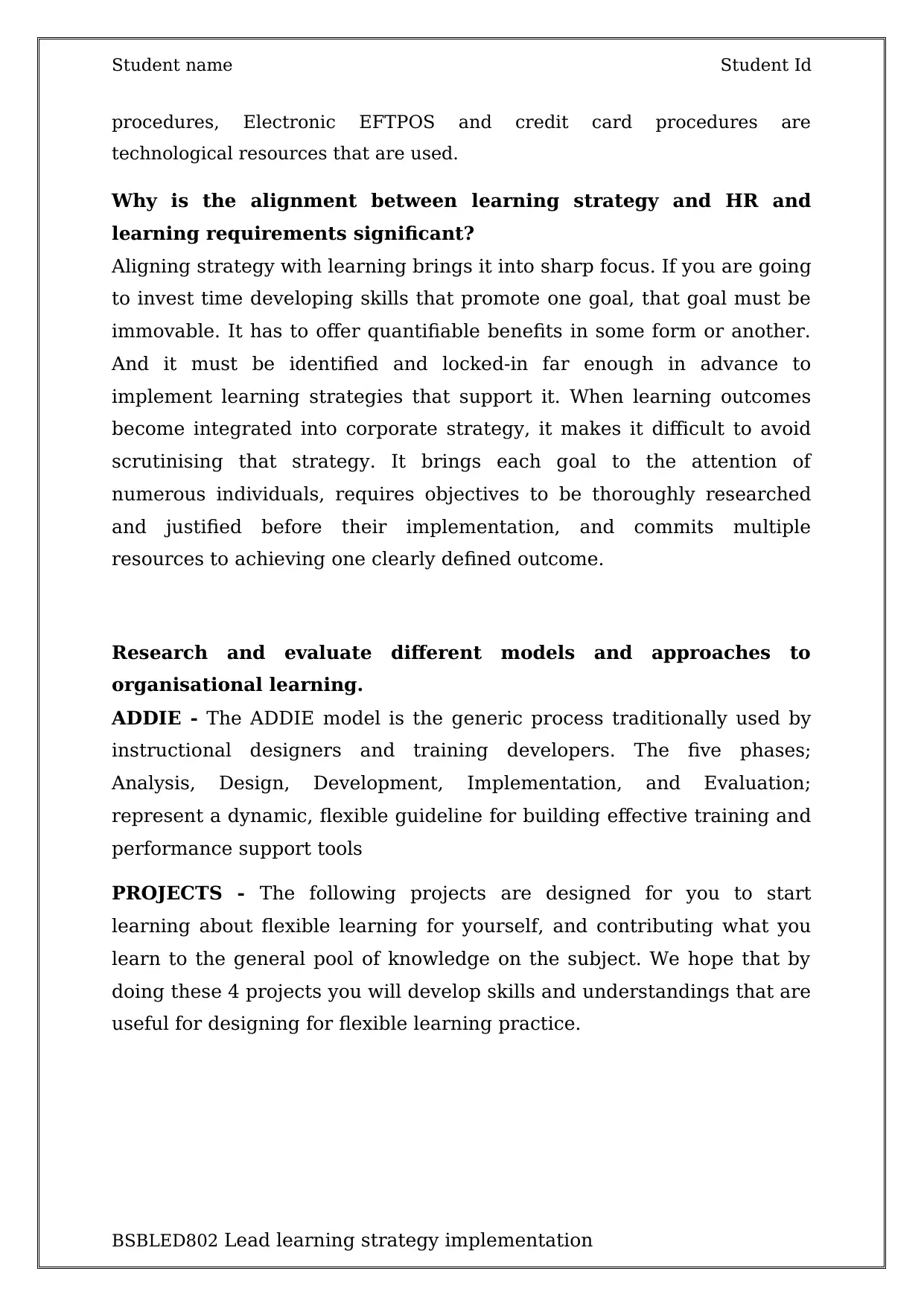
Student name Student Id
procedures, Electronic EFTPOS and credit card procedures are
technological resources that are used.
Why is the alignment between learning strategy and HR and
learning requirements significant?
Aligning strategy with learning brings it into sharp focus. If you are going
to invest time developing skills that promote one goal, that goal must be
immovable. It has to offer quantifiable benefits in some form or another.
And it must be identified and locked-in far enough in advance to
implement learning strategies that support it. When learning outcomes
become integrated into corporate strategy, it makes it difficult to avoid
scrutinising that strategy. It brings each goal to the attention of
numerous individuals, requires objectives to be thoroughly researched
and justified before their implementation, and commits multiple
resources to achieving one clearly defined outcome.
Research and evaluate different models and approaches to
organisational learning.
ADDIE - The ADDIE model is the generic process traditionally used by
instructional designers and training developers. The five phases;
Analysis, Design, Development, Implementation, and Evaluation;
represent a dynamic, flexible guideline for building effective training and
performance support tools
PROJECTS - The following projects are designed for you to start
learning about flexible learning for yourself, and contributing what you
learn to the general pool of knowledge on the subject. We hope that by
doing these 4 projects you will develop skills and understandings that are
useful for designing for flexible learning practice.
BSBLED802 Lead learning strategy implementation
procedures, Electronic EFTPOS and credit card procedures are
technological resources that are used.
Why is the alignment between learning strategy and HR and
learning requirements significant?
Aligning strategy with learning brings it into sharp focus. If you are going
to invest time developing skills that promote one goal, that goal must be
immovable. It has to offer quantifiable benefits in some form or another.
And it must be identified and locked-in far enough in advance to
implement learning strategies that support it. When learning outcomes
become integrated into corporate strategy, it makes it difficult to avoid
scrutinising that strategy. It brings each goal to the attention of
numerous individuals, requires objectives to be thoroughly researched
and justified before their implementation, and commits multiple
resources to achieving one clearly defined outcome.
Research and evaluate different models and approaches to
organisational learning.
ADDIE - The ADDIE model is the generic process traditionally used by
instructional designers and training developers. The five phases;
Analysis, Design, Development, Implementation, and Evaluation;
represent a dynamic, flexible guideline for building effective training and
performance support tools
PROJECTS - The following projects are designed for you to start
learning about flexible learning for yourself, and contributing what you
learn to the general pool of knowledge on the subject. We hope that by
doing these 4 projects you will develop skills and understandings that are
useful for designing for flexible learning practice.
BSBLED802 Lead learning strategy implementation
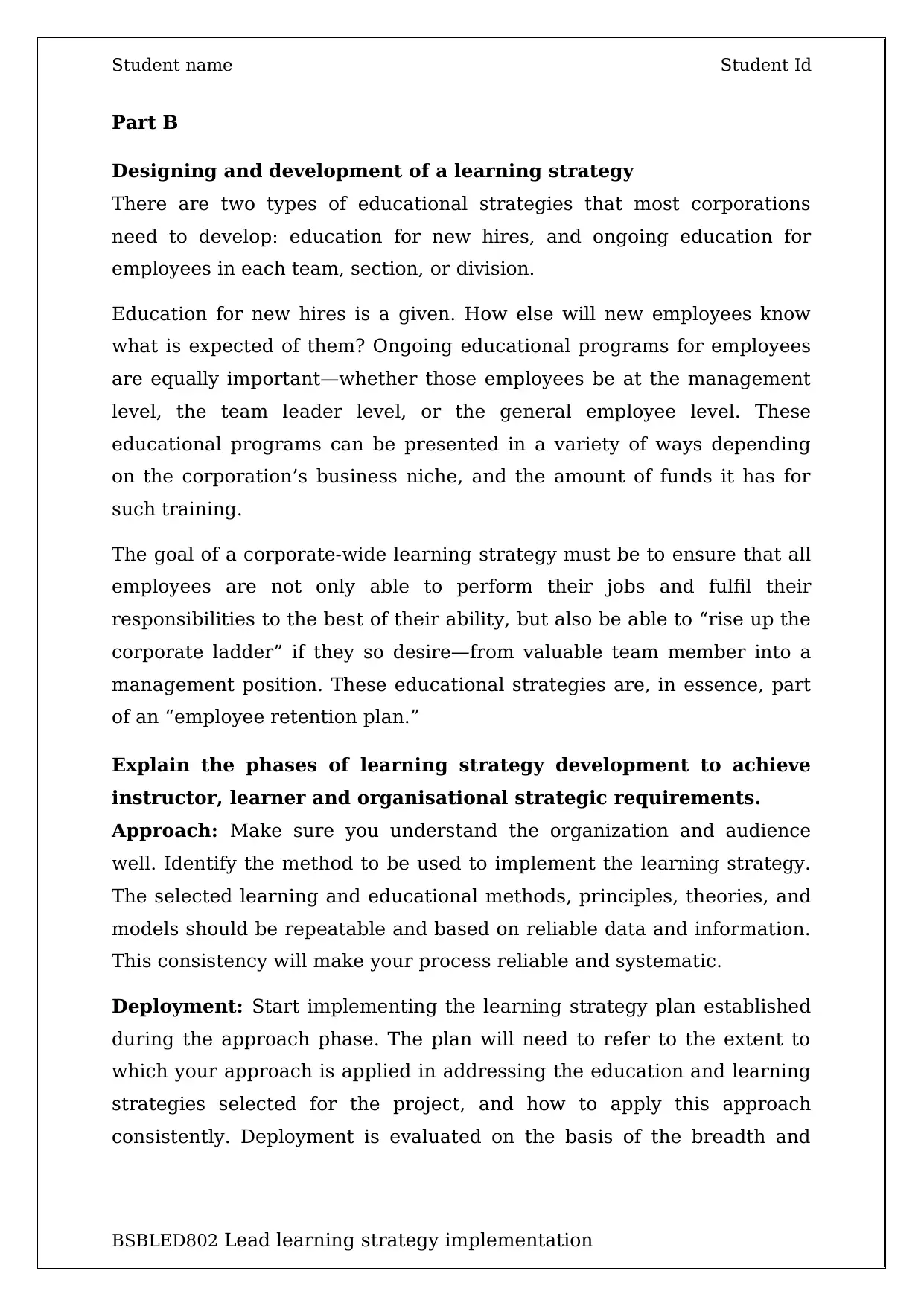
Student name Student Id
Part B
Designing and development of a learning strategy
There are two types of educational strategies that most corporations
need to develop: education for new hires, and ongoing education for
employees in each team, section, or division.
Education for new hires is a given. How else will new employees know
what is expected of them? Ongoing educational programs for employees
are equally important—whether those employees be at the management
level, the team leader level, or the general employee level. These
educational programs can be presented in a variety of ways depending
on the corporation’s business niche, and the amount of funds it has for
such training.
The goal of a corporate-wide learning strategy must be to ensure that all
employees are not only able to perform their jobs and fulfil their
responsibilities to the best of their ability, but also be able to “rise up the
corporate ladder” if they so desire—from valuable team member into a
management position. These educational strategies are, in essence, part
of an “employee retention plan.”
Explain the phases of learning strategy development to achieve
instructor, learner and organisational strategic requirements.
Approach: Make sure you understand the organization and audience
well. Identify the method to be used to implement the learning strategy.
The selected learning and educational methods, principles, theories, and
models should be repeatable and based on reliable data and information.
This consistency will make your process reliable and systematic.
Deployment: Start implementing the learning strategy plan established
during the approach phase. The plan will need to refer to the extent to
which your approach is applied in addressing the education and learning
strategies selected for the project, and how to apply this approach
consistently. Deployment is evaluated on the basis of the breadth and
BSBLED802 Lead learning strategy implementation
Part B
Designing and development of a learning strategy
There are two types of educational strategies that most corporations
need to develop: education for new hires, and ongoing education for
employees in each team, section, or division.
Education for new hires is a given. How else will new employees know
what is expected of them? Ongoing educational programs for employees
are equally important—whether those employees be at the management
level, the team leader level, or the general employee level. These
educational programs can be presented in a variety of ways depending
on the corporation’s business niche, and the amount of funds it has for
such training.
The goal of a corporate-wide learning strategy must be to ensure that all
employees are not only able to perform their jobs and fulfil their
responsibilities to the best of their ability, but also be able to “rise up the
corporate ladder” if they so desire—from valuable team member into a
management position. These educational strategies are, in essence, part
of an “employee retention plan.”
Explain the phases of learning strategy development to achieve
instructor, learner and organisational strategic requirements.
Approach: Make sure you understand the organization and audience
well. Identify the method to be used to implement the learning strategy.
The selected learning and educational methods, principles, theories, and
models should be repeatable and based on reliable data and information.
This consistency will make your process reliable and systematic.
Deployment: Start implementing the learning strategy plan established
during the approach phase. The plan will need to refer to the extent to
which your approach is applied in addressing the education and learning
strategies selected for the project, and how to apply this approach
consistently. Deployment is evaluated on the basis of the breadth and
BSBLED802 Lead learning strategy implementation
⊘ This is a preview!⊘
Do you want full access?
Subscribe today to unlock all pages.

Trusted by 1+ million students worldwide
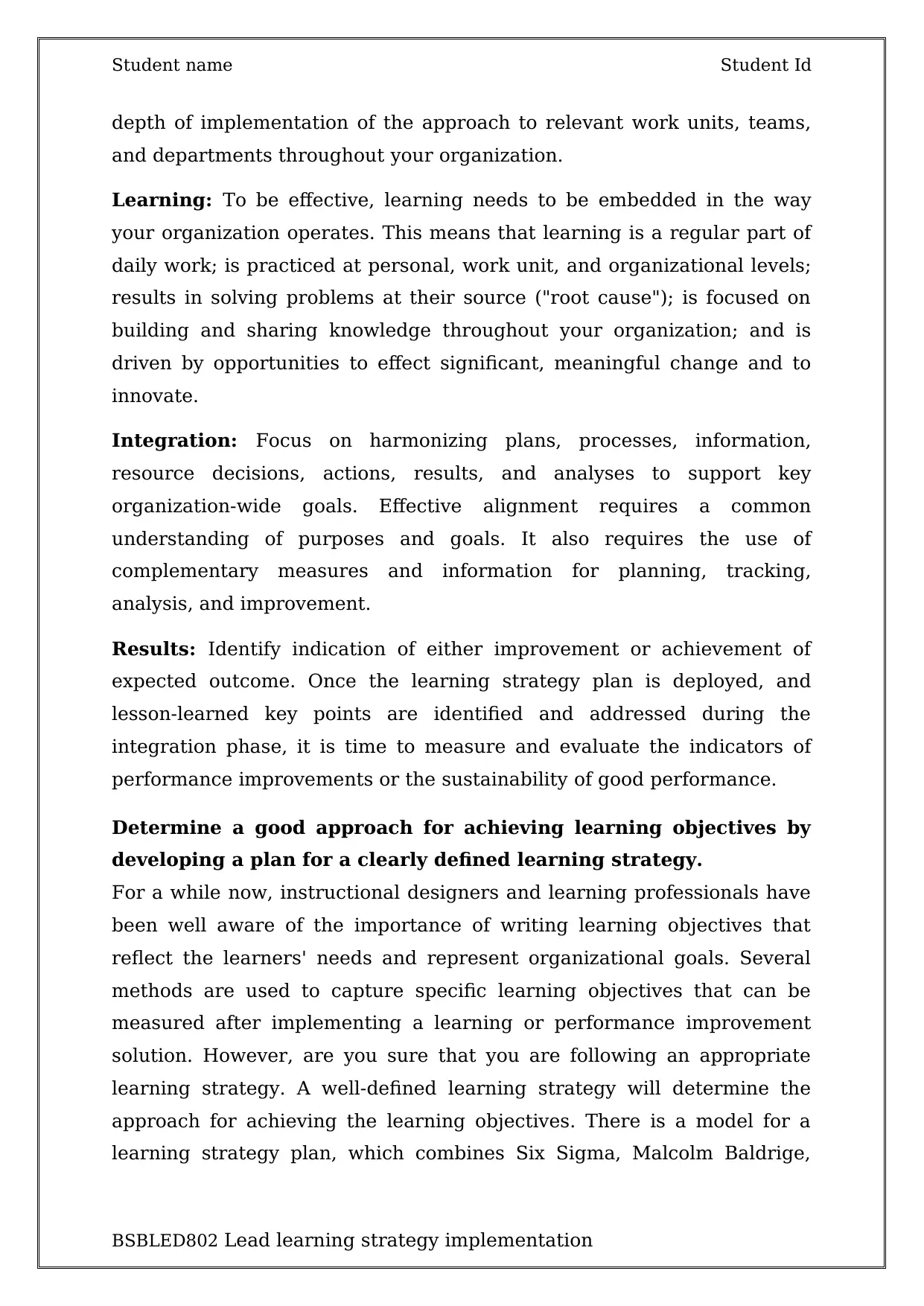
Student name Student Id
depth of implementation of the approach to relevant work units, teams,
and departments throughout your organization.
Learning: To be effective, learning needs to be embedded in the way
your organization operates. This means that learning is a regular part of
daily work; is practiced at personal, work unit, and organizational levels;
results in solving problems at their source ("root cause"); is focused on
building and sharing knowledge throughout your organization; and is
driven by opportunities to effect significant, meaningful change and to
innovate.
Integration: Focus on harmonizing plans, processes, information,
resource decisions, actions, results, and analyses to support key
organization-wide goals. Effective alignment requires a common
understanding of purposes and goals. It also requires the use of
complementary measures and information for planning, tracking,
analysis, and improvement.
Results: Identify indication of either improvement or achievement of
expected outcome. Once the learning strategy plan is deployed, and
lesson-learned key points are identified and addressed during the
integration phase, it is time to measure and evaluate the indicators of
performance improvements or the sustainability of good performance.
Determine a good approach for achieving learning objectives by
developing a plan for a clearly defined learning strategy.
For a while now, instructional designers and learning professionals have
been well aware of the importance of writing learning objectives that
reflect the learners' needs and represent organizational goals. Several
methods are used to capture specific learning objectives that can be
measured after implementing a learning or performance improvement
solution. However, are you sure that you are following an appropriate
learning strategy. A well-defined learning strategy will determine the
approach for achieving the learning objectives. There is a model for a
learning strategy plan, which combines Six Sigma, Malcolm Baldrige,
BSBLED802 Lead learning strategy implementation
depth of implementation of the approach to relevant work units, teams,
and departments throughout your organization.
Learning: To be effective, learning needs to be embedded in the way
your organization operates. This means that learning is a regular part of
daily work; is practiced at personal, work unit, and organizational levels;
results in solving problems at their source ("root cause"); is focused on
building and sharing knowledge throughout your organization; and is
driven by opportunities to effect significant, meaningful change and to
innovate.
Integration: Focus on harmonizing plans, processes, information,
resource decisions, actions, results, and analyses to support key
organization-wide goals. Effective alignment requires a common
understanding of purposes and goals. It also requires the use of
complementary measures and information for planning, tracking,
analysis, and improvement.
Results: Identify indication of either improvement or achievement of
expected outcome. Once the learning strategy plan is deployed, and
lesson-learned key points are identified and addressed during the
integration phase, it is time to measure and evaluate the indicators of
performance improvements or the sustainability of good performance.
Determine a good approach for achieving learning objectives by
developing a plan for a clearly defined learning strategy.
For a while now, instructional designers and learning professionals have
been well aware of the importance of writing learning objectives that
reflect the learners' needs and represent organizational goals. Several
methods are used to capture specific learning objectives that can be
measured after implementing a learning or performance improvement
solution. However, are you sure that you are following an appropriate
learning strategy. A well-defined learning strategy will determine the
approach for achieving the learning objectives. There is a model for a
learning strategy plan, which combines Six Sigma, Malcolm Baldrige,
BSBLED802 Lead learning strategy implementation
Paraphrase This Document
Need a fresh take? Get an instant paraphrase of this document with our AI Paraphraser
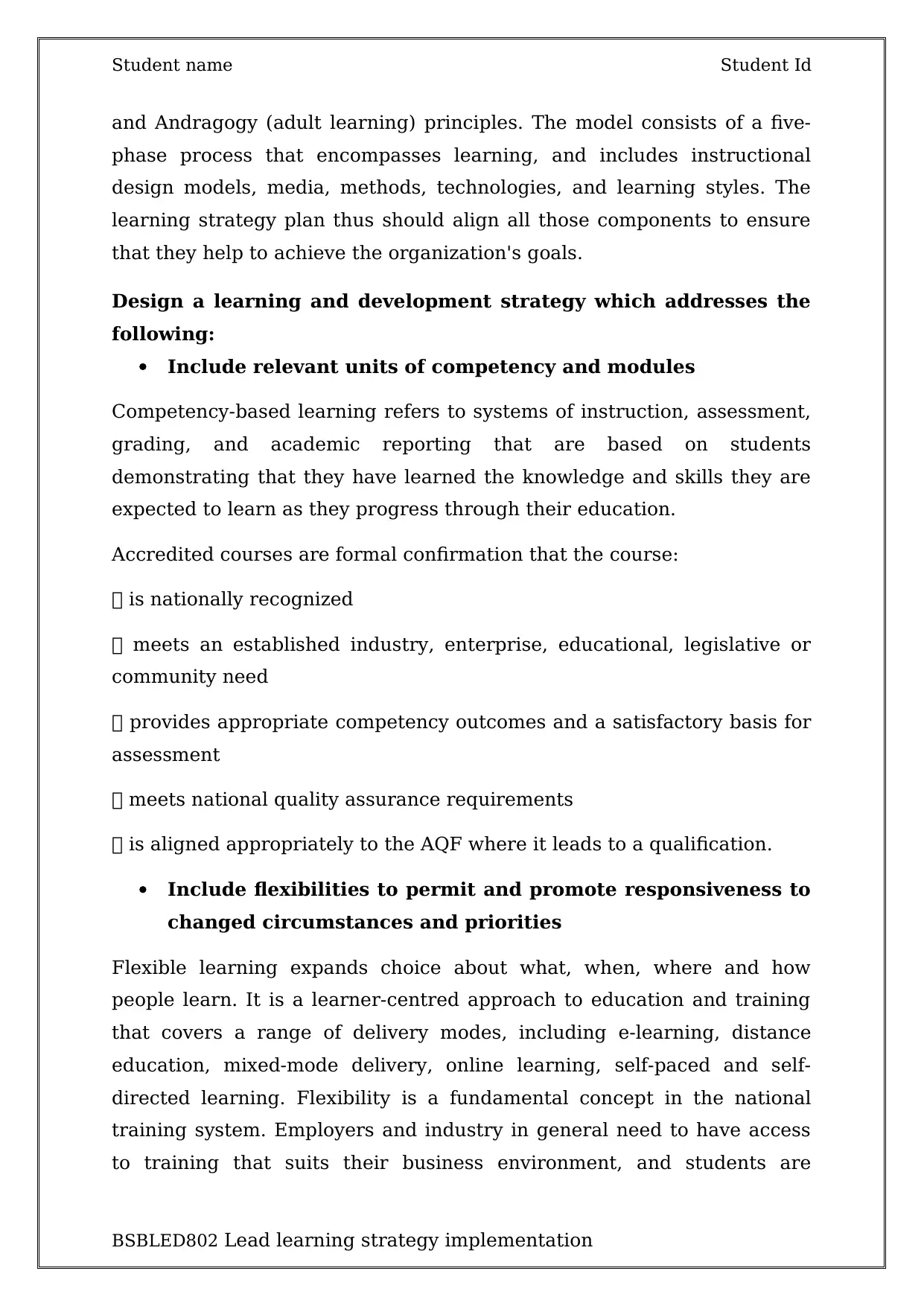
Student name Student Id
and Andragogy (adult learning) principles. The model consists of a five-
phase process that encompasses learning, and includes instructional
design models, media, methods, technologies, and learning styles. The
learning strategy plan thus should align all those components to ensure
that they help to achieve the organization's goals.
Design a learning and development strategy which addresses the
following:
Include relevant units of competency and modules
Competency-based learning refers to systems of instruction, assessment,
grading, and academic reporting that are based on students
demonstrating that they have learned the knowledge and skills they are
expected to learn as they progress through their education.
Accredited courses are formal confirmation that the course:
is nationally recognized
meets an established industry, enterprise, educational, legislative or
community need
provides appropriate competency outcomes and a satisfactory basis for
assessment
meets national quality assurance requirements
is aligned appropriately to the AQF where it leads to a qualification.
Include flexibilities to permit and promote responsiveness to
changed circumstances and priorities
Flexible learning expands choice about what, when, where and how
people learn. It is a learner-centred approach to education and training
that covers a range of delivery modes, including e-learning, distance
education, mixed-mode delivery, online learning, self-paced and self-
directed learning. Flexibility is a fundamental concept in the national
training system. Employers and industry in general need to have access
to training that suits their business environment, and students are
BSBLED802 Lead learning strategy implementation
and Andragogy (adult learning) principles. The model consists of a five-
phase process that encompasses learning, and includes instructional
design models, media, methods, technologies, and learning styles. The
learning strategy plan thus should align all those components to ensure
that they help to achieve the organization's goals.
Design a learning and development strategy which addresses the
following:
Include relevant units of competency and modules
Competency-based learning refers to systems of instruction, assessment,
grading, and academic reporting that are based on students
demonstrating that they have learned the knowledge and skills they are
expected to learn as they progress through their education.
Accredited courses are formal confirmation that the course:
is nationally recognized
meets an established industry, enterprise, educational, legislative or
community need
provides appropriate competency outcomes and a satisfactory basis for
assessment
meets national quality assurance requirements
is aligned appropriately to the AQF where it leads to a qualification.
Include flexibilities to permit and promote responsiveness to
changed circumstances and priorities
Flexible learning expands choice about what, when, where and how
people learn. It is a learner-centred approach to education and training
that covers a range of delivery modes, including e-learning, distance
education, mixed-mode delivery, online learning, self-paced and self-
directed learning. Flexibility is a fundamental concept in the national
training system. Employers and industry in general need to have access
to training that suits their business environment, and students are
BSBLED802 Lead learning strategy implementation
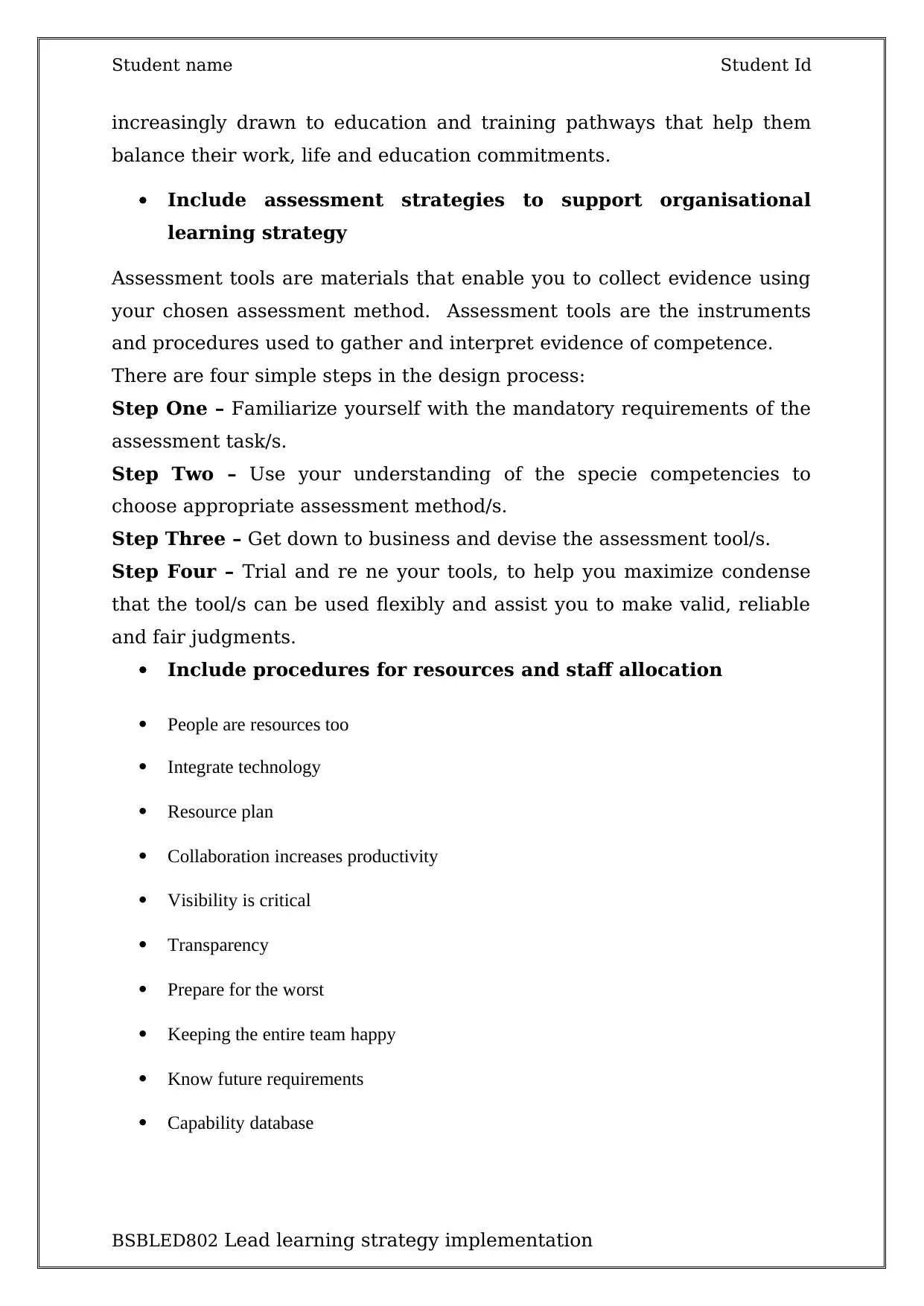
Student name Student Id
increasingly drawn to education and training pathways that help them
balance their work, life and education commitments.
Include assessment strategies to support organisational
learning strategy
Assessment tools are materials that enable you to collect evidence using
your chosen assessment method. Assessment tools are the instruments
and procedures used to gather and interpret evidence of competence.
There are four simple steps in the design process:
Step One – Familiarize yourself with the mandatory requirements of the
assessment task/s.
Step Two – Use your understanding of the specie competencies to
choose appropriate assessment method/s.
Step Three – Get down to business and devise the assessment tool/s.
Step Four – Trial and re ne your tools, to help you maximize condense
that the tool/s can be used flexibly and assist you to make valid, reliable
and fair judgments.
Include procedures for resources and staff allocation
People are resources too
Integrate technology
Resource plan
Collaboration increases productivity
Visibility is critical
Transparency
Prepare for the worst
Keeping the entire team happy
Know future requirements
Capability database
BSBLED802 Lead learning strategy implementation
increasingly drawn to education and training pathways that help them
balance their work, life and education commitments.
Include assessment strategies to support organisational
learning strategy
Assessment tools are materials that enable you to collect evidence using
your chosen assessment method. Assessment tools are the instruments
and procedures used to gather and interpret evidence of competence.
There are four simple steps in the design process:
Step One – Familiarize yourself with the mandatory requirements of the
assessment task/s.
Step Two – Use your understanding of the specie competencies to
choose appropriate assessment method/s.
Step Three – Get down to business and devise the assessment tool/s.
Step Four – Trial and re ne your tools, to help you maximize condense
that the tool/s can be used flexibly and assist you to make valid, reliable
and fair judgments.
Include procedures for resources and staff allocation
People are resources too
Integrate technology
Resource plan
Collaboration increases productivity
Visibility is critical
Transparency
Prepare for the worst
Keeping the entire team happy
Know future requirements
Capability database
BSBLED802 Lead learning strategy implementation
⊘ This is a preview!⊘
Do you want full access?
Subscribe today to unlock all pages.

Trusted by 1+ million students worldwide
1 out of 20
Related Documents
Your All-in-One AI-Powered Toolkit for Academic Success.
+13062052269
info@desklib.com
Available 24*7 on WhatsApp / Email
![[object Object]](/_next/static/media/star-bottom.7253800d.svg)
Unlock your academic potential
Copyright © 2020–2025 A2Z Services. All Rights Reserved. Developed and managed by ZUCOL.




